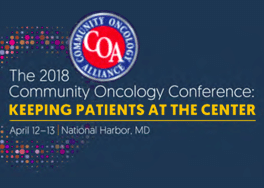 So what’s the progress in the Oncology Care Model and what’s coming next? During a panel discussion at the Community Oncology Conference OCM participants and a representative from Center for Medicare & Medicaid Innovation (CMMI) weighed in and offered their perspectives.
So what’s the progress in the Oncology Care Model and what’s coming next? During a panel discussion at the Community Oncology Conference OCM participants and a representative from Center for Medicare & Medicaid Innovation (CMMI) weighed in and offered their perspectives.
The moderator opened the discussion by asking the panel, in light of the fact that participating practices recently received their first year of financial results, what’s different now?
While the responses from both participating practices – Northwest Medical Specialties and Tennessee Oncology – were primarily positive, the both did acknowledge bumps early on in the model and the lack of clarity that lead them to re-calibrate along the way. Both panelists acknowledged that collaboration with CMMI has been really good and the tools and resources provided have been helpful.
One panelist noted, oncology is different and very complicated, so it’s no surprise that the model has its challenges. The fact that CMMI is a committed partner that wants OCM to work keeps participants optimistic.
CMMI’s representative noted that the ongoing input to improve the model is invaluable and she encouraged everyone to stay involved in the conversation. Specialty models are difficult for value-based care – and probably none more than oncology which includes different billing structures, a wide range of patients, limitations due to government regulations, challenges with provider buy-in and more. Success often depends on a deep commitment to a cultural change, which takes time, but hearing stories where the OCM has really made a difference in the lives of patients is a good motivator.
Next the moderator asked about the first year results. While Tennessee Oncology didn’t achieve shared savings in the first year, they have managed expectations so overall they are happy with the program. The practice was able to decrease all cost areas except drug costs, so they are confident they are moving in the right direction in terms of areas that are within their control.
CMMI commented that the fact that OCM practices are reducing acute care utilization is amazing. Unfortunately chemotherapy is too big of a portion of the total cost of care to be left out of the model, but she is hoping practices will share what they learn so the model can continue to be improved.
When asked about areas that need improvement, both panelists representing practices had similar answers: pricing, attribution and risk stratification. The cost of care estimate was also mentioned since it can be inaccurate and may be more scary than helpful for the patient. One panelist suggested an a model more focused on impact of cost and toxiciity to identify things that will really be beneficial for patient.
CMMI’s representative listed four specific things her organization it working to learn more about and encouraged the audience to contribute:
- Two-sided risk – how it could work better
- Attribution – she recognizes the frustration and wants to see it improved
- Quality measures – they are currently very process oriented, but they are looking for outcome oriented validated measures
- Clinical data – CMMI is collecting large amount and they want to ensure they are maximizing its value, using it to effectively evaluate the model and utilizing it to inform target prices
The future still seems a bit unclear for the OCM, but it was clear that everyone involved is committing to make it better and deliver better care to patients.
